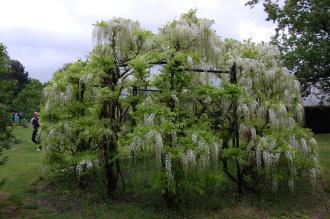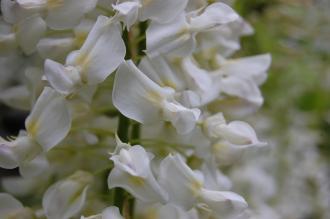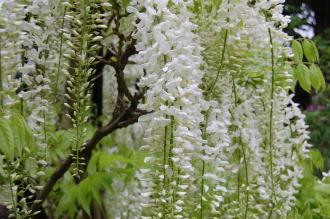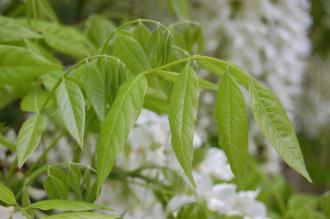
Wisteria floribunda ‘Alba’ (23/05/2015, Kew Gardens, London)
Position: Full sun to partial shade
Soil: Moist, well drained
Flowering period: Late spring to early summer
Eventual Height: 9m
Eventual Spread: Up to 5m
Hardiness: 5b, 6a, 6b, 7a, 7b, 8a, 8b, 9a, 9b
Family: Fabaceae

Wisteria floribunda ‘Alba’ Flower (23/05/2015, Kew Gardens, London)
Wisteria floribunda ‘Alba’ is a woody deciduous climber with a twining habit. Its mid green leaves are pinnate, composed of up to 13 leaflets and up to 30cm long. Its leaflets are ovate to elliptic with entire margins, up to 6cm long and 3cm across. Its leaves turn yellow in autumn before they fall. Its tendrils will twine around a support structure in a counter clockwise direction. Its fragrant white flowers are pea like, borne in long pendant racemes of up to 45cm and appear at the same time as its leaves. Its fruit are bean-like velvety green seed pods which are up to 10cm long.
The species, Wisteria floribunda, commonly known as Japanese Wisteria, is native to Japan.

Wisteria floribunda ‘Alba’ Flower Racemes (23/05/2015, Kew Gardens, London)
The etymological root of the binomial name Wisteria is named for Kasper Wistar, a German anatomy and anthropologist professor at the University of Penn, hence the occasional spelling Wistaria, although this was not the original spelling of the name. Floribunda is derived form the Latin floridus meaning ‘flowery’ and the epithet bundus meaning ‘having the capacity for’.
The landscape architect may find Wisteria floribunda ‘Alba’ useful as a fast growing fragrant climber with attractive flowers. This climber requires a support structure for its tendrils to twine around. It should be noted that grafted specimens will flower immediately, no grafted may take several years to flower.

Wisteria floribunda ‘Alba’ Leaf (23/05/2015, Kew Gardens, London)
Ecologically, Wisteria floribunda ‘Alba’ will attract pollinating insects such as bees that will feed on its nectar. All parts of this plant are mildly toxic to humans.
The Royal Horticultural Society have given Wisteria floribunda ‘Alba’ their prestigious Award of Garden Merit in 1993.
Wisteria floribunda ‘Alba’ prefers moist, fertile, well-drained soils. It tolerates most pH of soil. It dislikes dry soils.
Wisteria floribunda ‘Alba’ requires biannual pruning to promote good form and free flowering. A detailed description of pruning methods for Wisteria can be found here, including step-by-step instructions on how to train the plant into a self-supporting tree standard.

Landscape Architecture

